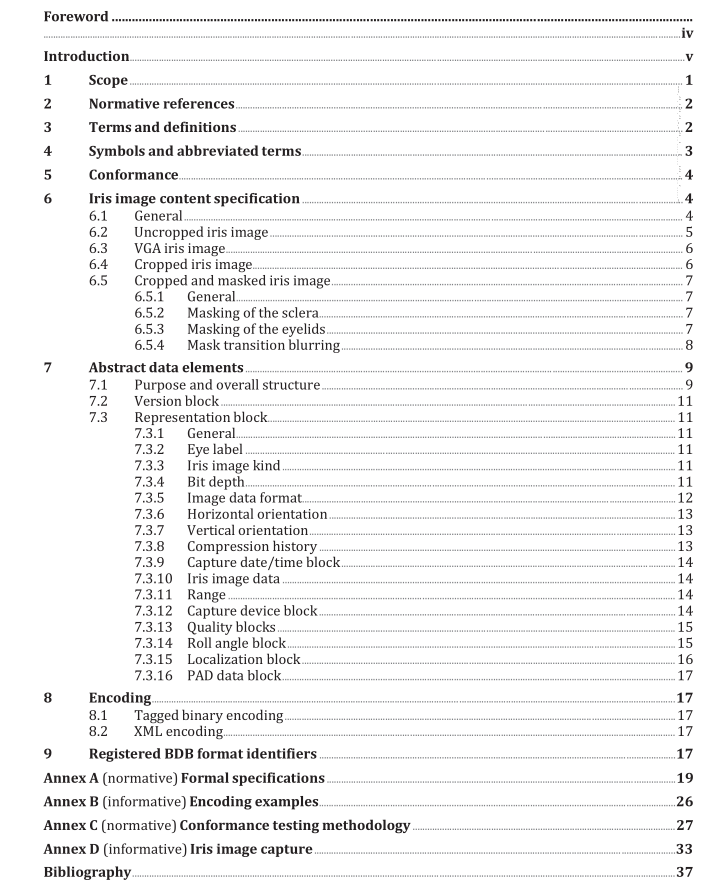ISO IEC 39794-6 pdf – Information technology — Extensible biometric data interchange formats — Part 6: Iris image data

ISO IEC 39794-6 pdf – Information technology — Extensible biometric data interchange formats — Part 6: Iris image data
5 Conformance
ABDB conforms to this document if it satisfies all of the requirements related to:
a) its data structure, data values and the relationships between its data elements as specifiedthroughout Clauses 6,7,8-and Annex A-of this document, and
b) the relationship between its data values and the input biometric data from which the biometric
data record was generated as specified throughout Clauses 6,7,8-and Annex A of this document.A system that produces biometric data records is conformant to this document if all biometric datarecords that it outputs conform to this document (as defined in points a) to b) above) as claimed in theICS associated with that system. A system does not need to be capable of producing biometric datarecords that cover all possible aspects of this document, but only those that are claimed to be supportedby the system in the ICS. The test for output record conformance shall be conducted in accordance withthe normative content of Annex C.
A system that uses biometric data records is conformant to this document if it can read, and use for thepurpose intended by that system, all biometric data records that conform to this document(as definedin points a) to b) above) as claimed in the ICS associated with that system.A system does not need to becapable of using biometric data records that cover all possible aspects of this document, but only thosethat are claimed to be supported by the system in an lcs.
A binary BDB conforms to this document if it satisfies the format requirements with respect to itsstructure, with respect to relations among its fields,and with respect to relations between its fieldsand the underlying input that are specified within A.1.
An XML document conforms to this document if it satisfies the format requirements with respect to itsstructure,with respect to relations among its fields, and with respect to relations between its fieldsand the underlying input that are specified within A.2.
6Iris image content specification
6.1General
This clause establishes requirements on the semantic content of the images that are allowed by thisdocument. These requirements relate to the geometric structure, pre-processing, compression protocol,format and dimensions of the image data.(Guidance on iris image capture is given in Annex D.) Imagedata may be uncompressed or compressed.If uncompressed, then it shal be encoded using PGM or PPMimage format.. All uncompressed raw images shall have an 8 bit pixel depth. Images with a pixel depthother than 8 bits shall be encoded using PNG or JPEG2000.
The remaining subclauses of Clause 6 group these requirements according to the type of image.As shown in Table 1, four image types are defined according to a hierarchy inherited from an unconstrained abstract basic iris image. The associated abstract values are provided in subclause 7.3.3. The requirements of Clause 7 establish the encoding specifications for the image. NOTE The specifications of image types, compression protocols, formats and cropping dimensions in this first edition of this document have been determined by the NIST Interoperable Iris Exchange (IREX-1) study (2009), which was commissioned for this purpose.
6.2 Uncropped iris image An uncropped iris image shall contain a raster scan image of a single eye. An example is shown in Figure 1. For an iris radius of R , there shall be margins of image data at least 0,2 R above and below the iris, and at least 0,6R to the right and left of the iris. These margins of image data shall be acquired from the actual object being imaged, not synthesized values. It is not assumed that the iris is centred within the image. If uncropped image data is compressed, then ideally it should be compressed losslessly. PNG shall not be used in its interlaced mode. If JPEG2000 is used, image data shall be stored in JPEG2000 format. The uncropped iris image type shall be identified in the iris record by assigning the abstract value uncropped to the iris image type element in subclause 7.3.3, as defined in Table 3.
6.3 VGA iris image A VGA iris image is a special case of the uncropped iris image; the image width shall be 640 pixels and the image height shall be 480 pixels. An example is shown in Figure 1 . Additional constraints of margins and container are inherited from the uncropped image type in subclause 6.2 .
If images are compressed, then images shall be compressed in accordance with either PNG or JPEG2000 for lossless compression, or JPEG2000 for lossy compression. The VGA iris image type shall be identified in the iris record by assigning the abstract value vGA to the iris image type element in 7.3.3, as defined in Table 3.









